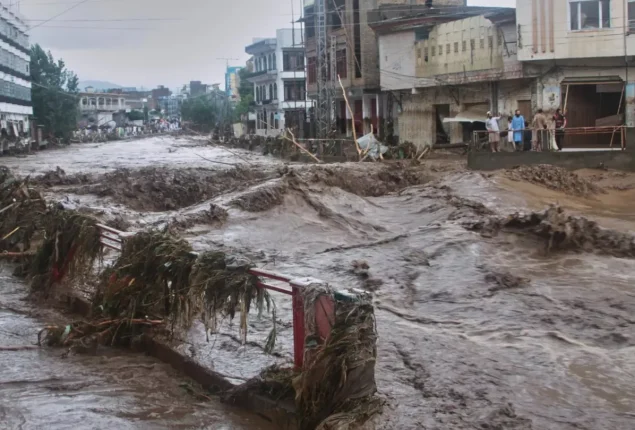India alerts Pakistan of potential major flood in River Tawi
Islamabad: India has alert Pakistan about a potential major flood situation in...

India alerts Pakistan on Tawi flood risk; evacuations continue as rivers rise.
ISLAMABAD/NEW DELHI: In a rare moment of cross-border cooperation, India has issued its third flood alert to Pakistan within just two days, warning of high water levels and potential flash floods in the Sutlej and Tawi rivers.
The alerts come in the wake of intense rainfall in Jammu & Kashmir, prompting India’s Meteorological Department to issue a red alert for the region. As a consequence, Indian authorities formally notified Pakistan of rising water levels likely to affect downstream areas across the border.
On Sunday, India communicated a warning at 10 a.m. via its High Commission in Islamabad, alerting Pakistan to a high flood in the Tawi River.
The next day, two separate alerts were issued — first at 10 a.m. regarding high water levels at Harike Barrage on the Sutlej River, and a second at 6 p.m., pointing to high flood conditions below Ferozepur.
These warnings were conveyed through diplomatic channels and not via the Indus Waters Treaty (IWT) mechanisms, as India had suspended treaty communications following the April 22 Pahalgam attack.
Nevertheless, the alerts mark a rare moment of cooperation and timely coordination during a humanitarian crisis.
Following India’s warning, Pakistan’s Ministry of Foreign Affairs confirmed receiving the alerts and passed the information to the National Disaster Management Authority (NDMA) and the Pakistan Meteorological Department to initiate preventive measures.
In Pakistan, the situation continues to worsen as a high flood has been declared at Guddu Barrage. The recorded upstream flow stands at 543,184 cusecs, while the downstream flow is at 507,853 cusecs, indicating a dangerous volume of water surging through the region.
The floodwaters have inundated multiple villages and large stretches of agricultural land across Sindh and South Punjab. Hundreds of families have been displaced, and standing crops particularly sugarcane have been submerged, causing significant damage to livelihoods in these rural areas.
Villages such as Bakhshan Shah, Abdul Rehman Wagon, Sajan Wagon, and Murad Chachar are among the most severely affected. Homes have been flooded, and local infrastructure has been overwhelmed, adding to the suffering of residents.
Despite the growing emergency, the response from local administrations has been slow and inadequate. Residents report a lack of organized evacuations, absence of medical camps, and no provision of shelters. As a result, many have been forced to flee on their own, carrying their livestock and belongings in search of safety.
Concerns have also been raised over illegal water pipe installations in key irrigation feeders — Begari Sindh Feeder, Desert Pat Feeder, and Ghotki Feeder — which may compromise the integrity of protective dykes. Authorities are yet to act decisively on this issue.
In Gilgit-Baltistan, flash floods have cut off over 3,000 residents in the Dain area of Ghizer district, where an old bridge was washed away. Emergency boats are being used to ferry people and supplies, while the reconstruction of an RCC bridge is pending federal assistance.
“Temporary boats are helping affected residents, but we need federal government support to restore full connectivity,” said GB government spokesperson Faizullah Faraq.
Meanwhile, relief operations continue in Talidas, where hundreds of families have been displaced.
While diplomatic tensions remain high, India’s proactive flood warnings have been described by Pakistani officials as a “good omen” for humanitarian cooperation between the two countries. Whether this spirit extends beyond flood alerts remains to be seen.
Catch all the International News, Pakistan News, Trending News, Breaking News Event and Latest News Updates on The BOL News
Download The BOL News App to get the Daily News Update & Follow us on Google News.